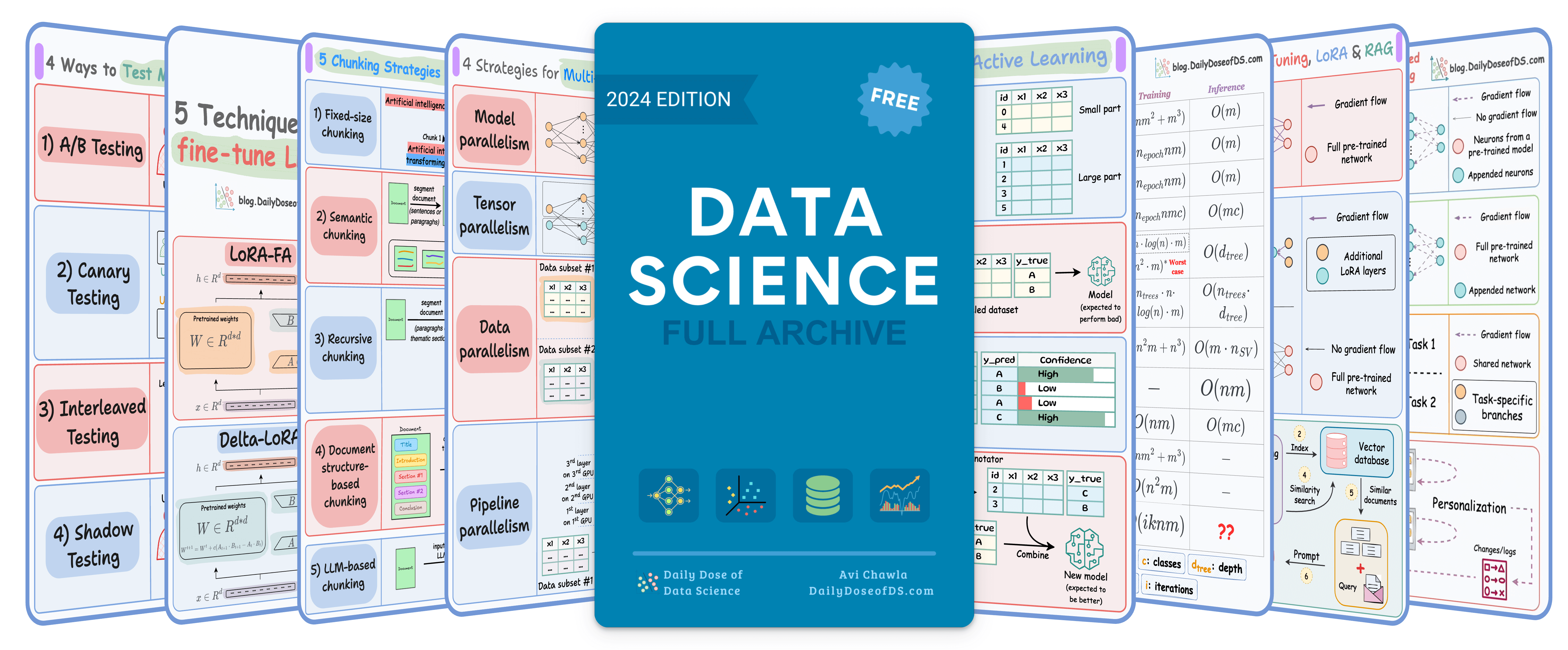

TODAY'S ISSUE
TODAY’S DAILY DOSE OF DATA SCIENCE
Traditional RAG vs. HyDE
One critical problem with the traditional RAG system is that questions are not semantically similar to their answers.

As a result, several irrelevant contexts get retrieved during the retrieval step due to a higher cosine similarity than the documents actually containing the answer.
HyDE solves this.
The following visual depicts how it differs from traditional RAG and HyDE.

Let's understand this in more detail today.
On a side note, we started a beginner-friendly crash course on RAGs recently with implementations. Read the first three parts here
Motivation
As mentioned earlier, questions are not semantically similar to their answers, which leads to several irrelevant contexts during retrieval.

HyDE handles this as follows:
- Use an LLM to generate a hypothetical answer
Hfor the queryQ(this answer does not have to be entirely correct). - Embed the answer using a contriever model to get
E(Bi-encoders are famously used here, which we discussed and built here). - Use the embedding
Eto query the vector database and fetch relevant context (C). - Pass the hypothetical answer
H+ retrieved-contextC+ queryQto the LLM to produce an answer.
Done!

Now, of course, the hypothetical generated will likely contain hallucinated details.
But this does not severely affect the performance due to the contriever model—one which embeds.
More specifically, this model is trained using contrastive learning and it also functions as a near-lossless compressor whose task is to filter out the hallucinated details of the fake document.
This produces a vector embedding that is expected to be more similar to the embeddings of actual documents than the question is to the real documents:

Several studies have shown that HyDE improves the retrieval performance compared to the traditional embedding model.
But this comes at the cost of increased latency and more LLM usage.
We will do a practical demo of HyDE shortly.
In the meantime...
We started a beginner-friendly crash course on building RAG systems. Read the first three parts here:
👉 Over to you: What are some other ways to improve RAG?
IN CASE YOU MISSED IT
Prompting vs. RAG vs. Fine-tuning
If you are building real-world LLM-based apps, it is unlikely you can start using the model right away without adjustments. To maintain high utility, you either need:
- Prompt engineering
- Fine-tuning
- RAG
- Or a hybrid approach (RAG + fine-tuning)
The following visual will help you decide which one is best for you:
Read more in-depth insights into Prompting vs. RAG vs. Fine-tuning here →
ROADMAP
From local ML to production ML
Once a model has been trained, we move to productionizing and deploying it.
If ideas related to production and deployment intimidate you, here’s a quick roadmap for you to upskill (assuming you know how to train a model):
- First, you would have to compress the model and productionize it. Read these guides:
- Reduce their size with Model Compression techniques.
- Supercharge PyTorch Models With TorchScript.
- If you use sklearn, learn how to optimize them with tensor operations.
- Next, you move to deployment. Here’s a beginner-friendly hands-on guide that teaches you how to deploy a model, manage dependencies, set up model registry, etc.
- Although you would have tested the model locally, it is still wise to test it in production. There are risk-free (or low-risk) methods to do that. Learn what they are and how to implement them here.
This roadmap should set you up pretty well, even if you have NEVER deployed a single model before since everything is practical and implementation-driven.
THAT'S A WRAP
No-Fluff Industry ML resources to
Succeed in DS/ML roles

At the end of the day, all businesses care about impact. That’s it!
- Can you reduce costs?
- Drive revenue?
- Can you scale ML models?
- Predict trends before they happen?
We have discussed several other topics (with implementations) in the past that align with such topics.
Here are some of them:
- Learn sophisticated graph architectures and how to train them on graph data in this crash course.
- So many real-world NLP systems rely on pairwise context scoring. Learn scalable approaches here.
- Run large models on small devices using Quantization techniques.
- Learn how to generate prediction intervals or sets with strong statistical guarantees for increasing trust using Conformal Predictions.
- Learn how to identify causal relationships and answer business questions using causal inference in this crash course.
- Learn how to scale and implement ML model training in this practical guide.
- Learn 5 techniques with implementation to reliably test ML models in production.
- Learn how to build and implement privacy-first ML systems using Federated Learning.
- Learn 6 techniques with implementation to compress ML models.
All these resources will help you cultivate key skills that businesses and companies care about the most.
SPONSOR US
Advertise to 600k+ data professionals
Our newsletter puts your products and services directly in front of an audience that matters — thousands of leaders, senior data scientists, machine learning engineers, data analysts, etc., around the world.





